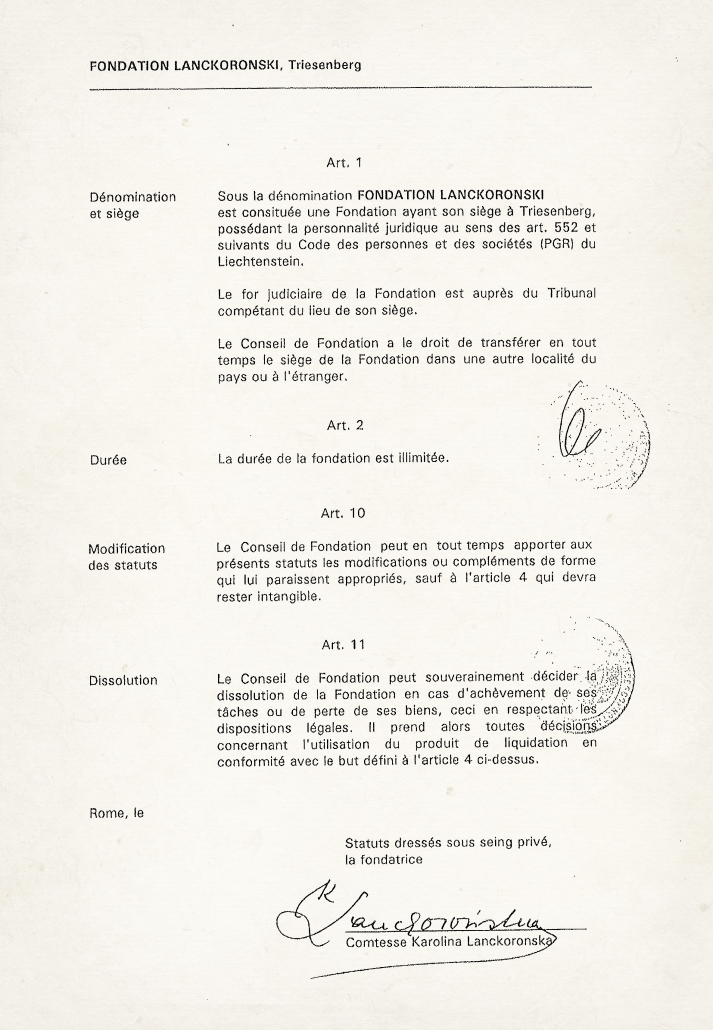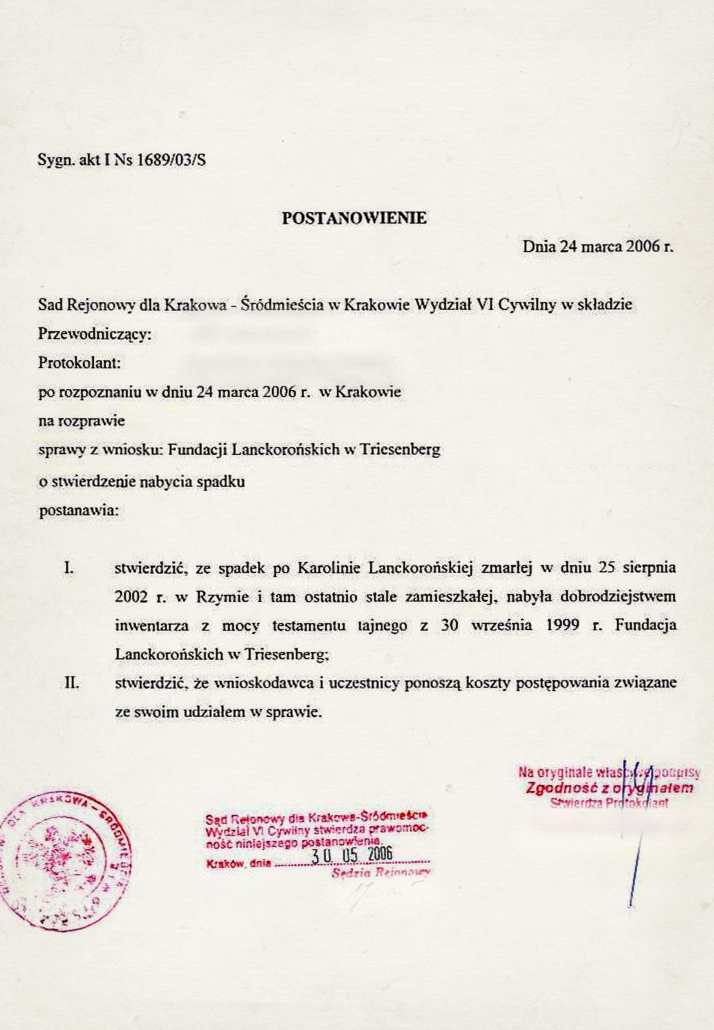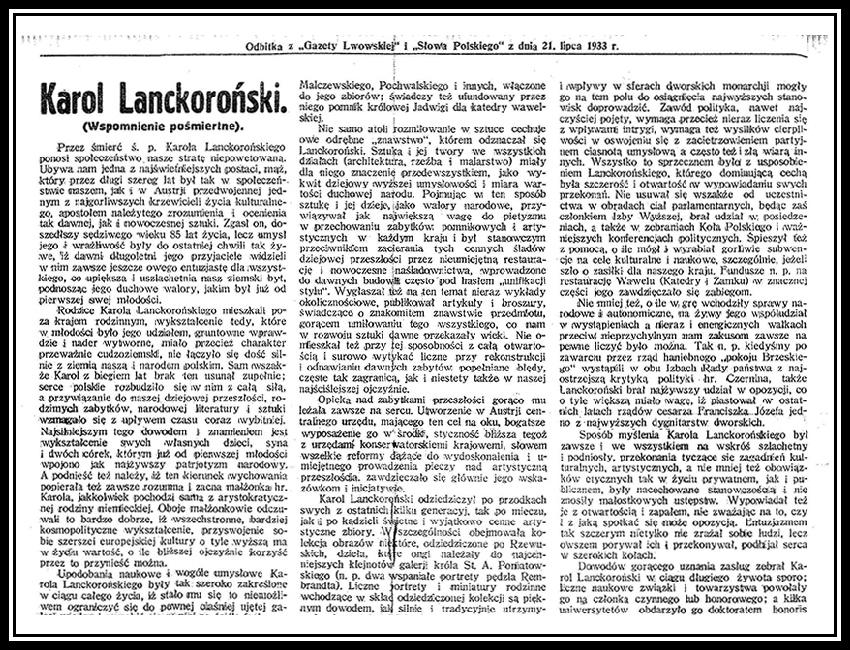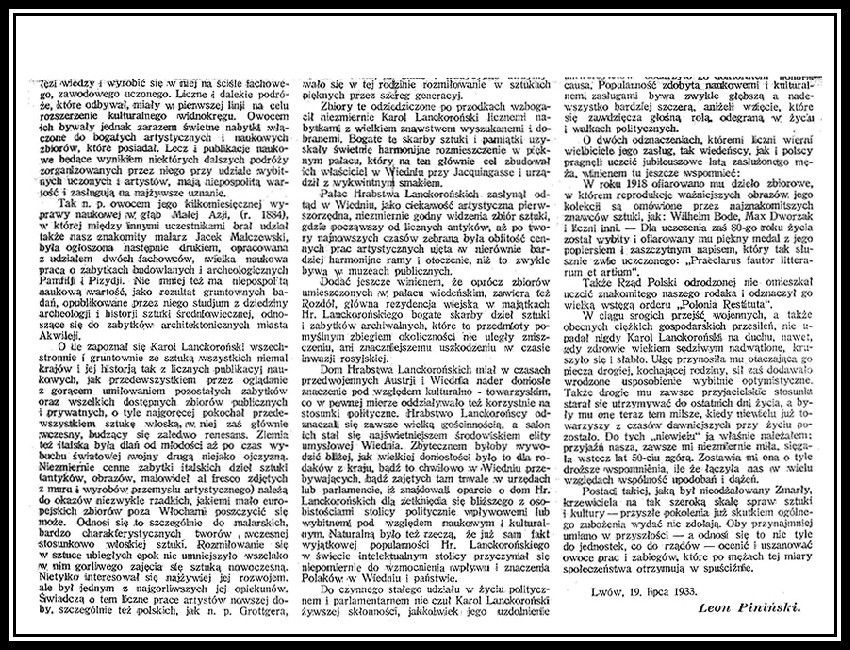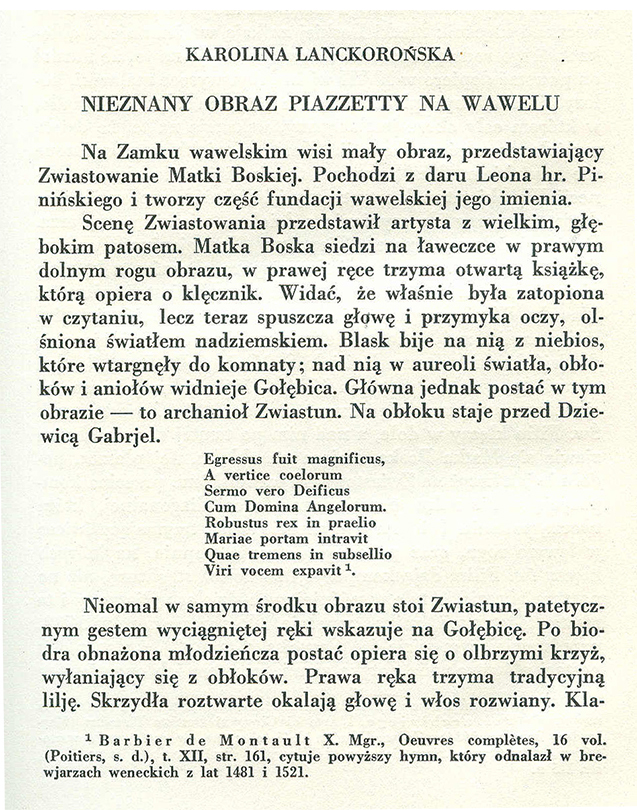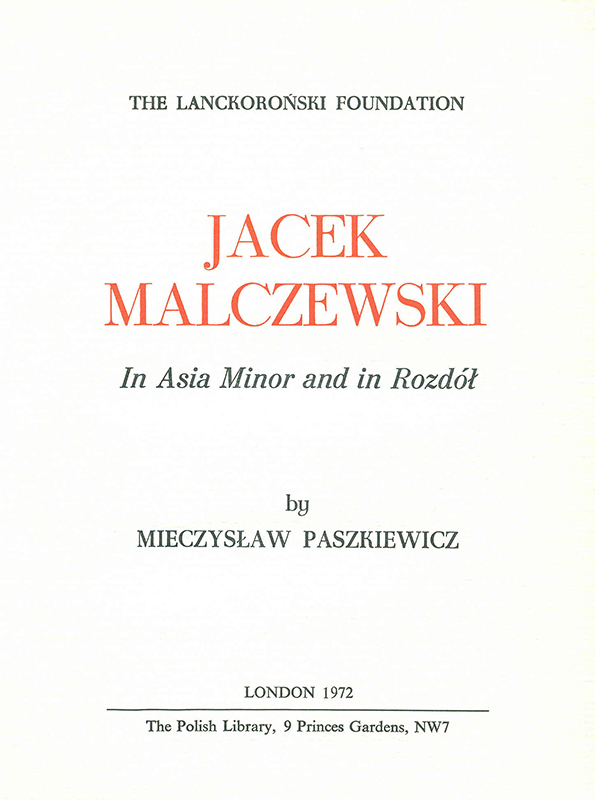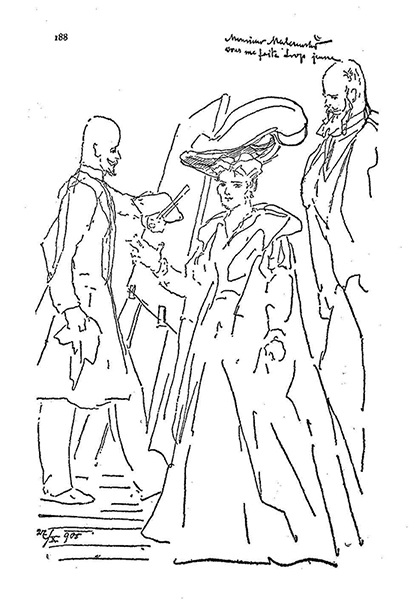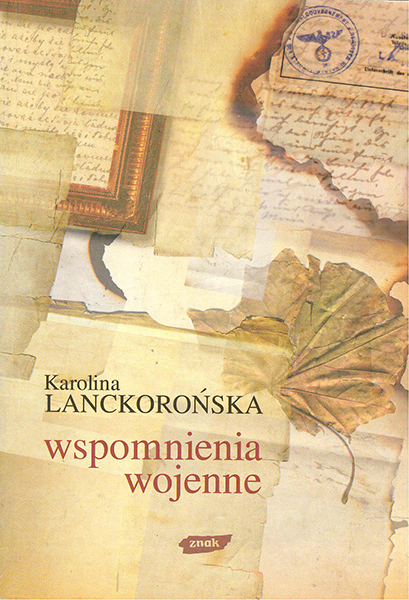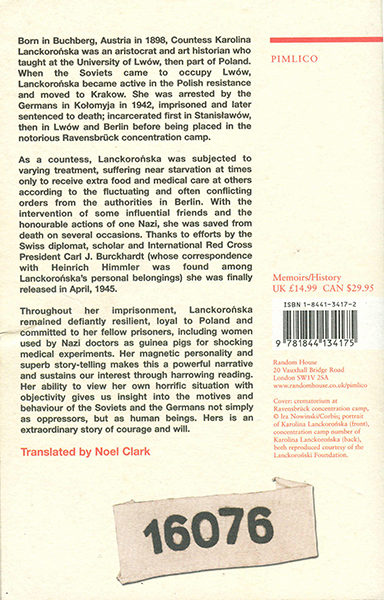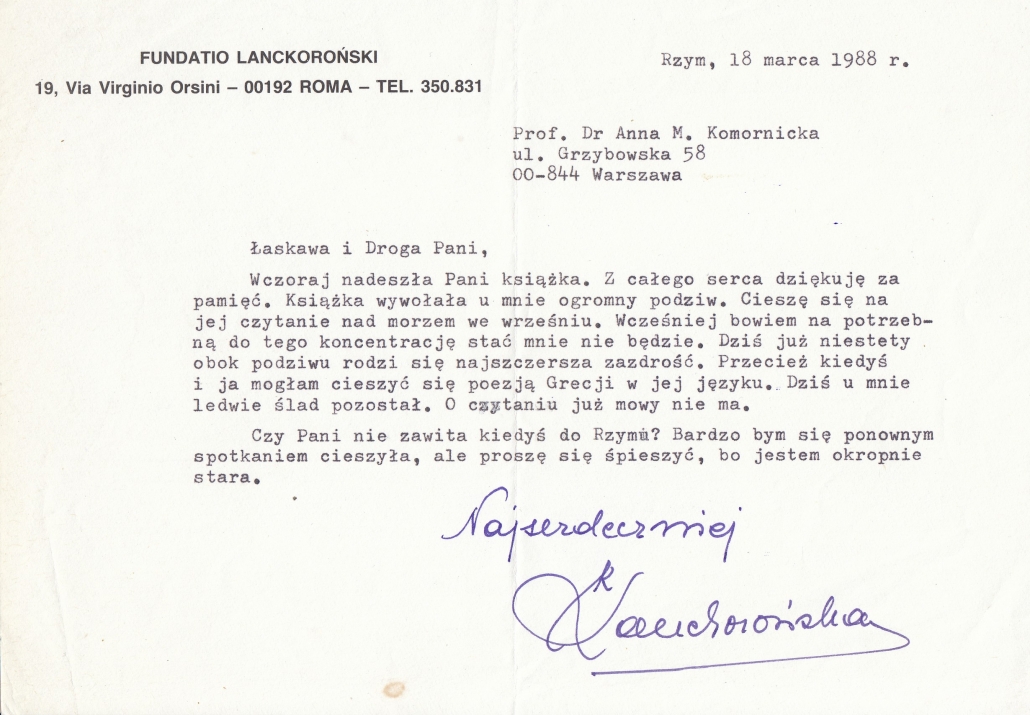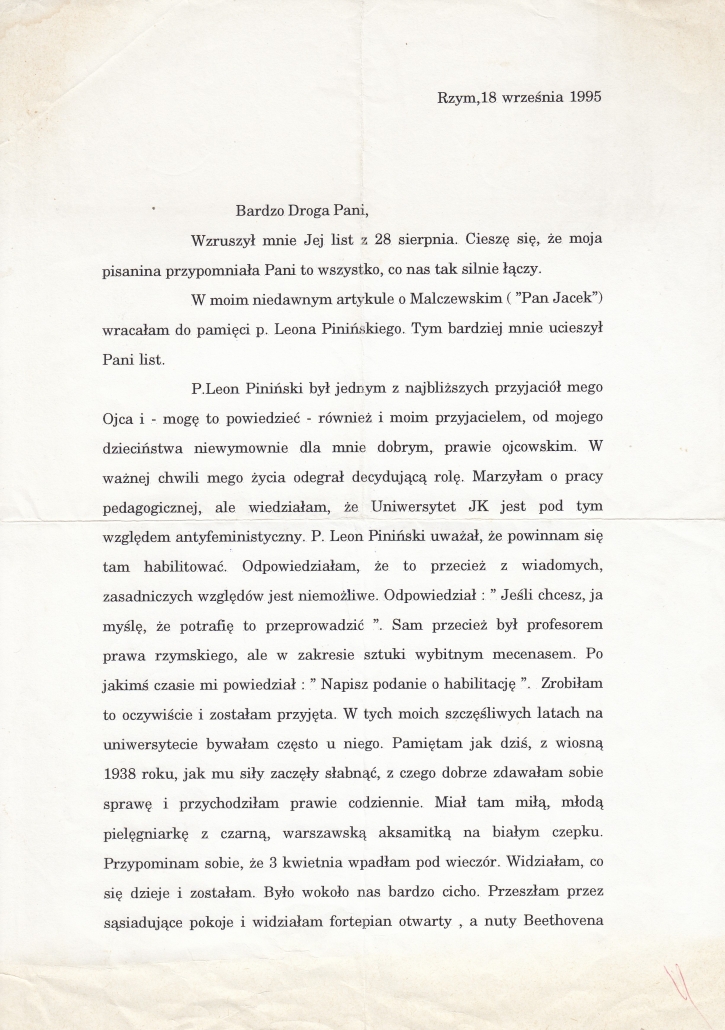Karol Lanckoroński

Karol Lanckoroński
Count Karol de Brzezie Lanckoroński, born on November 4th 1848 in Vienna and died there on July 15th 1933 (buried in the family tomb at the Hietzing cemetery in Vienna).
He came from a Polish aristocratic family bearing the Zadora coat of arms whose roots go back to the twelfth century. His father, Count Kazimierz Wincenty (1802-1874), born in Vienna, the son of Count Antoni Józef (1763-1830) and Ludwika née Rzewuski (1776-1839), was a privy councillor and court chamberlain. In 1843 he married Wanda Leonia Potocka (1821-1893), daughter of Leon (1790-1860) and Elżbieta née Countess Gołowin (1801-1867). After the death of his father Karol’s mother remarried Count Karl Vitzthum von Eckstädt (1819-1895) in 1875 in Paris, where the couple then settled.
In the years 1857-1858 Karol attended the Central School (Hauptschule) of Michael Zoller and Franz Aloys Bernard in Vienna. From 1858 he was given drawing lessons by the Viennese orientalist painter Leopold Carl Müller (1834-1892). In the period 1859-1866 he was a student of the Schottengymnasium – an elite school with a classical curriculum. On July 12th 1866 he matriculated and on December 13th of that year enrolled in the Faculty of Law at the University of Vienna. He graduated as a doctor of laws in 1873 and then spent “several years of study”, as he recalled in 1928, in Paris and London. His intellectual development was largely influenced by the classical philologist Wilhelm von Hartel (1839-1907) who later became Minister of Education in the government of the Austro-Hungarian Empire. The second person who undoubtedly influenced the educational profile and interests of Lanckoroński was Adolf Exner (1841-1894), a professor of Roman law. Interest in the theatre was probably instilled in him by his uncle Count Karol Michał (1799-1863) who was grand chamberlain at the imperial court in the years 1856-1863, custodian of the imperial art collections, an eminent connoisseur and lover of the theatre as well as a director of the Viennese court theatres for many years.

Karol Lanckoroński in the traditional dress of a Polish nobleman. This photograph was undoubtedly the basis for the Kazimierz Pochwalski’s portrait of him from circa 1919.
In January 1874 Lanckoroński went on a long journey to Italy. At the end of same year he travelled to Greece and from January to April of the year following traversed the entire Apennine Peninsula. Every year thereafter he spent a few weeks in Italy. In 1875 he set out on a journey to Spain which he visited with the Austrian painter Hans Makart, and at the end of the year they both left together for Egypt. In 1877 he travelled to Palestine and Syria, then in June 1887 went via Hamburg to England, Denmark and Sweden. In 1882 he started to journey ever deeper into Asia Minor, which exploration lasted four consecutive years. The first scientific archaeological expedition in which he participated and co-financed was a research expedition to Lycia in 1882 led by the Austrian archaeologist Otto Benndorf (1838-1907). In October 1882 he left Rhodes for Adalia (today’s Antalya), accompanied by, among others, the anthropologist and ethnographer Felix von Luschan (1854-1924) and the Austrian painter Leopold Bara (1846-1911). In March 1883 he visited Cilicia and again Antalya. The next year he went on a two-week tour of the south of France. In September 1884 Karol launched, organized and financed an archaeological expedition to Anatolia in which Professors Felix Luschan, Marian Sokołowski (1839-1911), George Niemann (1841-1912), Eugen Petersen (1836- 1919) and Wilhelm von Hartel partook, as well as two photographers, Moritz Hartel and Johann Georg Wasmuth, and the Polish painter Jacek Malczewski of whom Lanckoroński was a long-term friend and patron. The result was published in a two-volume book issued in three languages, German, French and Polish, entitled “The Cities of Pamphylia and Pisidia” (“Städte Pamphyliens und Pisidiens.” UnterMitwirkung von G. Niemann und E. Petersen, Karl von herausgegeben Graphene Lanckoroński, vol.I : “Pamphylien”, Vienna 1890, vol. II: “Pisidien”, Vienna 1892; the Polish version being “Miasta Pamfilii i Pizydii”, vol. I, trans. M. Sokołowski, Kraków 1890, vol. II, trans. M. Ćwikliński and P. Bieńkowski, Kraków 1896; the French one was “Les Villes de la Pamphylia et de la Pisidia”, trans. M. Colardeau, vol. I, Paris 1890, vol. II, Vienna 1892). The archaeological research of 1882-1884 brought Lanckoroński international recognition – he became a member of the German and Austrian Archaeological Institute in 1891 and of the Polish Academy of Learning in Kraków in 1893 as well as a corresponding member of Akademie der Wissenschaften in Vienna. On March 25th 1907 he received an honorary doctorate from the Jagiellonian University in Kraków and the same title was also awarded to him by the University of Berlin. His renown as a researcher and expert on antiquity was strengthened by the restoration work of the Cathedral of Aquileia which was financed by him, led by George Heinrich Niemann and Heinrich Swoboda (1861-1929), culminating in the publication of the monumental work entitled “Der Dom zu Aquileia. Sein Bau und seine Geschichte. Unter Mitwirkung von Georg Niemann und Heinrich Swoboda, herausgegeben von Karl Grafen Lanckoroński”, Vienna 1906.
In December 1888 Lanckoroński set out on an expedition around the world. From Marseille he went to Colombo in Ceylon and on to India as far as the border with Afghanistan, then alongside the Himalayas to Calcutta and Darjeeling. From there he travelled to Singapore, Hong Kong, Guangzhou and Japan. On June 24th 1889 he sailed from Yokohama to San Francisco and within a month crossed the United States by train from west to east. In August 1889 he arrived in Southampton from which he set off for London and Vienna. His impressions from the trip are described in the book “Around the Globe. Impressions and Ideas”, published in German (1890) and Polish (1893). In 1891, together with the sculptor Caspar Zumbusch (1830-1915), he visited Corfu and Albania. In the summer of 1912, along with his son Antoni, he travelled via Berlin and Hamburg to Glasgow and Edinburgh before leaving for Iceland; in May 1929 he went to Spain and Portugal with his daughter Karolina, which was probably his last significant journey.
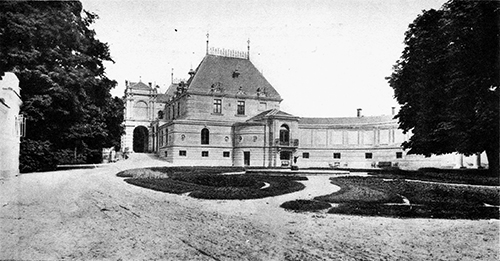
Rozdół – the façade of the palace and its right wing viewed from the side.
After the death of his father in 1874 Karol inherited a parliamentary seat in the Austrian House of Lords in Vienna. From 1877 he was a curator of the royal and imperial Österreichisches Museum für Kunst und Industrie (now the Österreichisches Museum für angewandte Kunst) and likewise of the Handelsmuseum in Vienna. Probably in 1898 he joined the council for the arts (Kunstrat) in the Ministerium für Kultus und Unterricht. In 1910 he was appointed vice-president of the Verein zum Schutze und zur Erhaltung der Kunstdenkmaler Wiens und Niederöstrereich; he was a member of the Viennese associations Altertums-Verein and Verein der Museumsfreunde as well as Goethe-Verein. In 1910 he became vice-president of the Staatsdenkmalamt (Office for the protection of monuments) and the crowning achievement of his career in the state institutions of the Austro-Hungarian Empire came with his appointment by the emperor to the office of grand chamberlain on February 14th 1914. There was little he could do, as he himself later admitted. Owing to the outbreak of the First World War many of his projects remained on paper. In 1917 he resigned from this position and gradually withdrew from public life. He had yet to play a significant role in the international Restitution Commission dealing with repossession of cultural property belonging to the states created after the collapse of the Austro-Hungarian Empire, including Poland. In 1903 he was awarded the Order of the Golden Fleece and on May 3rd 1928 the Order of Polonia Restituta.
Thanks to the strenuous efforts of Count Karol Lanckoroński and the Viceroy of Galicia Professor Count Leon Piniński as well as the Speakers (or marshalls) of the Galician Parliament Count Stanisław Badeni and Mikołaj Zyblikiewicz, the Royal Castle of Wawel in Kraków was recovered from the Austrians. The fact that the Austrian army had for years (and with devastating effect) been garrisoned in the former seat of the kings of Poland was described by Lanckoroński as a “disgrace of culture” (“Kulturschande”) during a speech he made in the Austrian Parliament. Together with Piniński he was actively involved in the renewal of both the Wawel Castle and the Wawel Cathedral, for which Lanckoroński founded the tombstone of Queen Jadwiga and the commemorating plaque in tribute to Cardinal Zbigniew Oleśnicki.
Karol Lanckoroński’s extensive correspondence of more than 2,000 letters and manuscripts preserved in the collection of the Austrian National Library in Vienna is evidence of his contacts with many famous persons. His art collections, estimated at more than 3,000 objects included paintings of the Italian, German, Austrian, French and Dutch schools, was partly inherited from his ancestors (including works from the former collection of King Stanisław August Poniatowski) but much of it was acquired by him personally (Italian painting from the fourteenth to the sixteenth century, and works of contemporary artists). His collections also included works of ancient art (Greek, Roman, but also ancient Egyptian) which amount to about 1,000 objects, art and craft from China, India and Japan, as well as porcelain, tapestries, coins and miniatures. In order to house them Lanckoroński built a large neo-baroque palace in Vienna at 18 Jacquingasse in the years 1892-1894. Designed according to his instructions by the Viennese architectural firm Fellner & Helmer, it became a meeting place for the Viennese and international intellectual elite and was one of the most important salons of the Austrian capital.
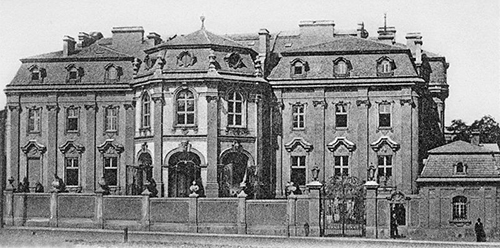
The Lanckoroński Palace in Vienna
Karol Lanckoroński’s first wife was Princess Maria Salm-Reifferscheidt-Raitz (1859-1897), the daughter of Prince Hugh zu Salm-Reifferscheidt-Raitz (d. 1890) and Princess Elizabeth of Liechtenstein (d. 1894). The marriage which took place in 1878 was childless and in 1882 was annulled. On August 17th 1892 he remarried and his second wife was Countess Franziska Xaveria von Attems-Heiligenkreuz (1861-1893), the daughter of Count Anton von Attems-Gilleis, a chamberlain and member of the Austrian Parliament. In 1893 a son Antoni was born (d. February 8th 1965), however, Franziska died soon after his birth, on August 8th. Lanckoroński then married for the third time, to Princess Margarethe von Lichnowsky (1863-1954), and the ceremony took place on July 14th 1897 on the estate of Lichnowsky Grätz (now Hradec, near Opava). Margarethe, the youngest of three children of Prince Karl Maria Lichnowsky (1819-1901) and Princess Maria von Croÿ (1837-1915), came from a Prussian aristocratic family which had settled in Silesia. Her great-grandfather Prince Karl von Lichnowsky (1761-1814) was Beethoven’s patron and to him the composer dedicated the sonatas Opus 13 “Pathétique” and Opus 26, amongst others. His grandfather, the historian Prince Eduard von Lichnowsky (1787-1845), was the author of an eight volume history of the House of Habsburg published in the period 1836-1844. His uncle, Prince Felix von Lichnowsky (1814-1848) was both a friend and patron of Franz Liszt. Margarethe’s brother, Prince Karl Max (1860-1928), was the German ambassador to Great Britain in 1912-1914 and his wife was the writer Countess Mechtilde von und zu Arco-Zinneberg (1878-1958).
In Vienna Lanckoroński owned the palace at 18 Jacquingasse in the 3rd district and a neighbouring house at 16 Jacquingasse as well as a town house at 6 Wasagasse in the 9th district, sold by his daughter Karolina Lanckorońska in 1972, as well as the Faniteum – a complex of 4.303 hectares located in Ober St. Veit which was created as a mausoleum for his second wife Franziska. The Faniteum was built between 1894-1896 by Emmanuel La Roche (1863-1922) and comprised a convalescent home for girls (with frescoes by Wilhelm Steinhausen 1846-1924) and a chapel in the style of the Tuscan Renaissance as well as surrounding grounds. In the 1970s Karolina Lanckorońska sold the entire complex to the Carmelites whose convent is located there today. During the Second World War it was used as a headquarters for the German Luftwaffe. Lanckoroński was also the owner of estates in Styria: Frauenwald and Steinhaus, and Pfaffenwald, Einöd as well as Mühlen. In Polish Galicia he owned the estate of Wodzisław north of Kraków (in 1926 the estate had an area of 1,793 ha), the palace and estate of Rozdół south of Lwów (today in the Ukraine), the castle and estate of Jagielnica south of Tarnopol (today in the Ukraine) formerly owned by Stanisław Lanckoroński, commander-in-chief of the Polish army, and the palace and estate of Komarno south-west of Lwów (also today in the Ukraine). Lanckoroński inherited the classical palace of his grandmother’s Rzewuski ancestors in Rozdół which he commissioned Julian Zachariewicz to rebuild in the neo-Renaissance style and which was completed in the years 1874 to 1880. The palace on the estate of Komarno and located in the village of Chłopy was probably designed by George Niemann according to information obtained in 2014 from Professor Hubert Szemethy in Vienna.
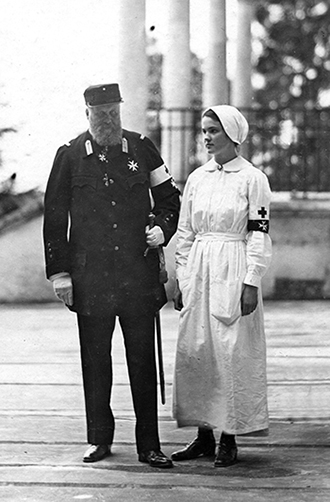
Karol Lanckoroński with his daughter Karolina as a nurse in the Faniteum during the First World War during which it was used as a convalescence home for soldiers, Vienna 1916.
After Karol Lanckoroński’s death his estates were inherited by his children. Antoni (1892-1965) inherited Wodzisław, Rozdół and Jagielnica. In 1938 Rozdół comprised 2,525 hectares, including farmland and forestry, a brewery, two flour mills, a mill for the production of vegetable oil, brickworks, a quarry and a sawmill. In 1937 Jagielnica comprised 6,631 hectares, consisting of farmland, forestry and carp ponds. During the interwar period there were also two distilleries, a sawmill, brickworks, flour mills and even two railways sidings and mechanical workshops. Jagielnica was famous for its horse-breeding, mainly for supplying the army, and was one of the largest such studs in the south-east of Poland. Cattle farming was also carried out at a very high level. These estates were very severely damaged during the First World War but thanks to the efforts of Karol Lanckoroński and his considerable investment they were repaired, rebuilt and modernized.
Karolina (1898-2002) and Adelajda (1905-1980) jointly inherited Komarno, the property which Ludwika Lanckorońska née Rzewuska acquired in 1803 as compensation for debts owed by Prince Michał Kazimierz Ogiński to her grandfather Franciszek Rzewuski. Komarno comprised 7,300 hectares in 1937, including farmland, forestry and carp ponds. All estates owned by the Lanckoroński family were run with a very high level of professionalism.
Karolina and Adelajda also inherited from their father the tenement house at 6 Wasagasse in Vienna. The Viennese palace at 18 Jacquingasse was probably left to Antoni, although in Karol’s will there is no specific instruction with regard to the palace or its collections. In 1939 the collection, which still remained in the palace, was seized by the Nazis and in 1943 taken to Thürntal and Alt Aussee. The palace itself, severely damaged by bombing in March 1945, was looted and partially burned. It remained a ruin until 1960 when it was demolished and today the Hotel Daniel stands on the site. However, memory of the palace is commemorated by a plaque unveiled in November 2014. The art collections were returned to the owners in the autumn of 1947 and later partially sold. In the years 1994 and 2000 the remaining part was donated by Karolina Lanckorońska to various Polish cultural institutions. Eighty seven Italian paintings, drawings by Jacek Malczewski and other family documents were given to the Royal Castle of Wawel in Kraków, the Polish Academy of Learning in Kraków and the Jagiellonian Library of the University of Kraków. Other works of art and memorabilia inherited from the Rzewuski family, including thirty seven paintings from the collection of the last King of Poland, Stanisław August Poniatowski as well as a valuable collection of furniture, were given to the Royal Castle in Warsaw.
Karolina Lanckorońska
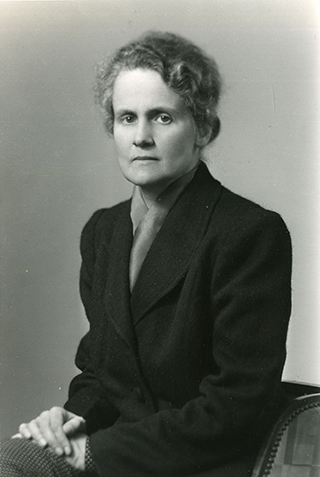
Karolina Lanckorońska

Rozdół 1905. (from left) Countesses Adelajda and Karolina Lanckorońska by Jacek Malczewski.
Countess Karolina Lanckorońska, co-heiress of the estate of Komarno near Lwów, was the daughter of Count Karol and Countess Margarethe née Princess von Lichnowsky (1863-1957). She was born on August 11th 1898 in Buchberg am Kamp in Lower Austria and died on August 25th 2002 in Rome where she is buried at the cemetery of Campo Verano.
She attended the Schottengymnasium in Vienna, the same school from which her father had graduated. She was taught Polish by teachers employed by her father, including Eleanor Rzeszotko, the wife of Zdzislaw Krudzielski.
In 1920 Karolina successfully completed her schooling and then as a private student started studying the history of art at the University of Vienna, initially under the direction of Max Dvořák and then after his death in 1921 under Julius von Schlosser. In 1926 she defended her doctoral thesis “Studien zum Michelangelos jüngste Gericht und seiner künstlerischen Entwicklung” (unpublished) and the same year went to Rome where she worked as a librarian at the subsidiary of the Polish Academy of Learning, organizing the book and photographic library donated to that institution by her father. Continuing her academic career she became a member of the Society for Historical Research in Lwów in 1934 and began the process of being accepted as a lecturer (namely an associate or junior professor, or in Polish docent) at the Jan Kazimierz University of Lwów in October the same year. In this she succeeded the following year on the basis of her published work “The decoration of the Church del Gesù in Rome in the context of the development of the Baroque in Rome”. She was the first woman to hold that academic rank in the field of the history of art at any Polish university and the initial reticence associated with granting this position to a female, notwithstanding her obvious merit, was overcome thanks to the support of Professor Count Leon Piniński.
Karolina Lanckorońska was in Rome when the Second World War broke out but immediately returned to Lwów and by the turn of 1939 and 1940 was lecturing at Lwów University which was now in the hands of the Ukrainians under the control of the Soviet communists. She had also already become a member of the Polish Resistance, then called the Union of Armed Struggle (later the Home Army) the oath for which she took in January 1940. In May that year, fearing arrest, she escaped from Russian-occupied Lwów and made her way to Kraków where she re-established herself within the Resistance and carried out the orders of General Tadeusz Bór-Komorowski whose wife Irena had been a longstanding friend, as well as dedicating herself to helping the sick and wounded.
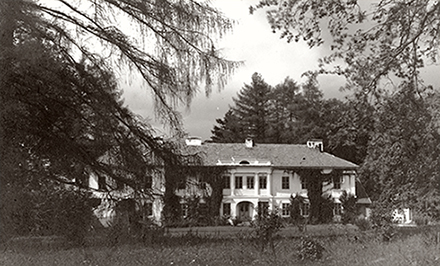
The palace in the village of Chłopy on the Komarno estate.
In Kraków Karolina began operations in the Central Welfare Council (RGO), an organisation tolerated by the Nazis which provided help for those arrested and in need. From January to May 1942 she worked as the council’s director in Stanisławów for seventeen districts of Poland’s south-east. However, her activity began to arouse the growing suspicion of the Germans. On May 12th 1942 she was arrested in Kołomyja during a council meeting and then imprisoned in Stanisławów. During the interrogation the Gestapo head, Hans Krüger, admitted to her in a fit of rage that he had been responsible for the murder of the Polish professors of Lwów University on the night of July 3rd 1941. He did so as he felt sure he was only revealing the truth to a person who would herself soon be executed. In this way Karolina Lanckorońska became the only Polish witness to Krüger’s crime regarding which she testified in 1967 in Münster during the legal proceedings against the German oppressors of Stanisławów’s civilian population. Contrary to Krüger’s presumption Karolina avoided the death sentence thanks to the intercession of members of the Italian Royal Family with Himmler. From Stanisławów she was transported to the prison on Łącki Street in Lwów where she remained from July 8th to November 27th 1942. Whilst being held there she made an extensive fourteen page report to Walter Kutschmann, one of the heads of the Gestapo in Drohobycz, on the murder of the Lwów professors which incriminated Krüger. A copy was sent to the rector of the University of Lwów, Professor Stanisław Kulczyński (1895-1975). From Lwów she was transported to the prison in Berlin on Alexanderplatz where on January 8th 1943 she was sent to the Ravensbrück concentration camp. On April 5th 1945, one month before the end of the war, she was released through the intervention of Carl Burckhardt (1891-1974), President of the Red Cross. She described her two year confinement in Ravensbrück in her book “Wspomnienia Wojenne” (translated into German and English), having soon after her release published a short text entitled “Souvenirs de Ravensbrück / Erlebnisse aus Ravensbrück” in the “Revue suisse universitaire”, XIX, 1945/1946, No. 2.

The funeral of Countess Irena Komorowska, widow of General Tadeusz Bór-Komorowski, London 1968. In the first row: General Władysław Anders (standing, left) , Count Stanisław Piniński (far right), between them in front of the coffin is the son of the deceased, Adam Komorowski, and behind him is his godmother, Professor Countess Karolina Lanckorońska.
In 1945, shortly after the end of the war, Lanckorońska was offered the chair of the History of Art at the University of Fribourg in Switzerland. She refused because she wanted to teach Poles. As press officer for the Polish second corps under General Władysław Anders she took on the task of organizing educational courses for Polish soldiers and settled in Rome at nr 19 Via Virginio Orsini.
In November of 1945 she incorporated the Polish Historical Institute in Rome, the founding document of which she signed together with Father Walerian Meysztowicz. The main activity of the institute was to publish source documents in foreign archives relating to Polish history. In 1954 Volume I of the annual ” />
Karolina Lanckorońska dedicated her family inheritance to “public causes”, in the words of Mieczysław Paszkiewicz, and in 1967 she and her brother and sister created the Lanckoronski Foundation, undoubtedly on Karolina’s initiative. It was registered in Switzerland and in 1977 a subsidiary charity was incorporated in the UK. The Foundation supports Polish research in the humanities, financing researchers who wish to study abroad, something which after the war was extremely difficult and costly. It also supported Poles whose country found itself behind the Iron Curtain, by sending them medicine, financial assistance as well as books, including those for various Polish academic institutions. Karolina remained president of the Lanckoronski Foundation until 1988 and was succeeded in turn by Count Jan Badeni (till 1995), Count Zygmunt Tyszkiewicz (till 2013) and Count Piotr Piniński (from 2013), all of whom were appointed to the Foundation by her personally, whilst the Foundation presently has its seat in Liechtenstein.
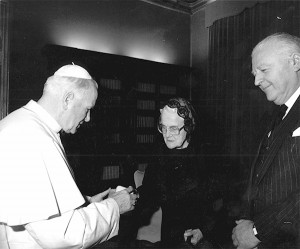
Pope John Paul II in 1994 with Professor Countess Karolina Lanckorońska and Count Jan Badeni (then President of the Lanckoronski Foundation).
After the fall of communism in 1989 she received a Polish passport – after the Second World War, as a result of which Poland lost its independence, her patriotism did not allow her to apply to become a national of any other country. In 1990 she became a member of the Polish Academy of Learning in Kraków and in 1983, in recognition of her contribution to Polish learning, the Jagiellonian University of Kraków awarded her an honorary doctorate. She was given the same distinction in 1988 by the London-based Polish University Abroad and also in 1990 by the University of Wrocław. In 1995, the City of Kraków awarded her with the silver medal “Cracoviae Merenti” and on May 27th 1991 she was decorated with the Grand Cross of the Order of Polonia Restituta.
In 1972 a family archive which comprised her father’s correspondence, diaries and manuscripts was given by Karolina to the Austrian National Library. She decided to sell some of the most valuable paintings from her father’s surviving collection in order to support and even save certain Polish cultural institutions abroad, including the Polish Library in Paris which at one time was threatened with closure. In 1994 she took the decision to donate the remainder of her family’s collection of art to Polish museums which had been severely impoverished as a consequence of the Second World War. The Royal Castle of Wawel in Kraków received eighty seven Italian paintings dating from the fourteenth to the seventeenth century, two hundred and twenty drawings and several letters all by Jacek Malczewski, a numismatic collection, a large number of engravings and various family documents. The Royal Castle in Warsaw was given thirty seven paintings inherited by the Lanckorońskis from their Rzewuski ancestors, including those acquired from the collection of the last King of Poland, Stanisław August Poniatowski, amongst which were two portraits by Rembrandt, family documents, postcards with reproductions of works from the Lanckoroński collection and a valuable collection of French furniture. Numerous documents relating to the family were transferred to the Archives of the Polish Academy of Science and the Polish Academy of Learning in Kraków whilst a collection of drawings and prints was donated to the Jagiellonian Library in Kraków. After the Second World War all the Polish estates which had belonged to the Lanckorońskis were nationalised by the communists without any recompensation. Of them all were located in that part of pre-war Poland which was lost to the Ukraine, with the single exception of Wodzisław. Komarno, which Karolina had jointly inherited was nationalised and divided into small units and the palace in Chłopy is today a ruin. The paintings which were in Rozdół are now partly in the Lwów National Gallery of Art and the Museum of Drohobycz, a significant number of them having been stolen.
Karolina Lanckorońska never married and died childless.
Adelajda Lanckorońska
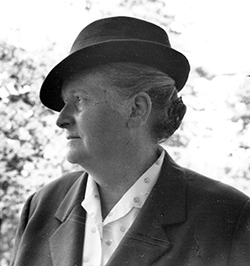
Adelajda Lanckorońska, circa 1950.
Countess Adelajda Lanckorońska, co-heiress of the estate of Komarno near Lwów, was the daughter of Count Karol and Countess Margarethe née Princess von Lichnowsky (1863-1957). She was born on February 5th 1903 in Vienna and died on September 15th 1980 in Gossau near Zurich and is buried in that city.
Adelajda was educated at home. In her youth she was interested in music, especially singing in which she was trained in Vienna and Paris. However her vocal range was insufficient for her to pursue such a career. She travelled extensively throughout Europe and until 1935 lived with her mother in Vienna. The outbreak of war in 1939 found her in Rozdół from which she escaped with her brother, firstly to Rumania and then to Switzerland where she settled in the city of Zurich. In 1955 she received the citizenship of the Canton of Zurich. After the war ended she supported herself on income from the estate in Austria which her family managed to recover. She also taught foreign languages, gave financial support to young musicians of Polish origin, and was an active member of the Association of Polish Ladies in Zurich. In 1967, together with her sister Karolina she co-founded the Lanckoronski Foundation and became a member of its Council.
Adelajda Lanckorońska never married and died childless.
Antoni Lanckoroński

Antoni Lanckoroński in Rome, 1955.
Count Antoni Lanckoroński, heir of the estates of Jagielnica near Tarnopol, Rozdół near Lwów and Wodzisław near Kraków, was the son of Count Karol and Countess Franziska née von Attems Heiligenkreuz (1861-1893). He was born on August 8th 1893 in Vienna and died on February 8th 1965 in Vienna where he is buried in the family tomb in the Hietzing Cemetery.
In 1912 Antoni Lanckoroński graduated from the Schottengymnasium in Vienna. In October that year he joined the Austrian 2nd Lancers based in Lwów where he qualified as an officer. In October 1913 he began to study law at the Jagiellonian University of Kraków, which course he did not complete as in August 1914 he was called up to rejoin the 2nd Lancers in Tarnów. From September 1914 he served in the 4th Lancers and from April 1915 he served in the Kraków garrison. The year following he was transferred to the corps under General Baron Leopold von Hauer at the front in Wołyń. Antoni was promoted to the rank of lieutenant in May 1917 and in August that year was released from active duty by a decision of the Minister of War. He joined the newly formed Polish Army on August 1st 1920 in which he served as an adjutant on the staff of the Operational Group of the 6th Army under General Władysław Jędrzejewski. In October 1920 he was discharged and in 1934 transferred to the reserve.
In the interwar period Antoni managed his estates of Wodzisław, Jagielnica and Rozdół which in the year 1923 he had bought from his father in a legal move designed by his father to partially protect his heirs from the government’s policy of enforced parceling and sale. Antoni proceeded to rebuild the estates after the devastation caused by the First World War and with a huge effort and significant investment made them highly profitable. In Jagielnica he bred Simmental cattle, Merino sheep, pigs of the English Large White breed and created the largest stud in south-east Poland producing thoroughbred and half-thoroughbred horses for the army. For his achievements in this field he received several awards and diplomas from the Ministry of Military Affairs. In Wodzisław he bred full and half-blood Arabians as well as Dutch cows. He was a member of the Podolian Equestrian Club in Tarnopol, southern-central Polish Equestrian Club in Jarosław, the Arab Horse Breeding Society in Warsaw and the Association of Half-Thoroughbred Horse Breeders in Lwów.
In 1919 the United Landowners association in Lwów elected Antoni as a member of the board of the United Landowners with the task of regulating employee relationships with agricultural labourers. In 1937, on behalf of the Association of Landowners in Jędrzejów, Antoni co-financed the equipment and furnishings of the town’s hospital which had been built thanks to National Defence Fund.
He financially supported the parish of Ułaszkowce, the building of churches in Muchawka and Rosochacz, the orphanages in Jagielnica and Rosochacz as well as the paramilitary Riflemen’s Association “Strzelec” and the Military Training Organization – as a result of which in 1937 he received the honorary badge of the Border Defence Corps. Antoni also became a well-known social activist and was a member of the Tarnopol Provincial Committee for the Co-ordination of Polish Social Organizations as well as vice-president of the Polish-Austrian Chamber of Commerce in Vienna. For his business and social work as well as efforts towards national defence his candidature was submitted in 1939 for the Order of Polonia Restituta.
In January 1925 Karolina and Adelajda granted Antoni a power of attorney to act on their behalf with regard to the management of their estate, as a result of which he became the de facto administrator of all the Lanckoroński estates which existed during the inter-war period. Antoni also managed the Lanckoroński estates in Austria which included, amongst others, the palace in Vienna with its valuable collections of art. In 1938 he began proceedings to bring the collections to Poland but the Second World War broke out before he was able to do so. In September 1939 he left Rozdół with his sister Adelajda and escaped to Romania and then to Switzerland. In the years 1939-1945 he worked for the International Red Cross in Geneva where he ultimately settled.
Antoni co-financed the activities of the Polish Historical Institute in Rome and in 1960 created the Karol Lanckoroński Fund which supported Polish academic and cultural institutions abroad as well as Polish scholars in exile. After his death his sisters Karolina and Adelajda transformed the Fund into the Lanckoronski Foundation which continues to function to the present day.
Antoni Lanckoroński never married and with his death the male line of the family became extinct.
The above biographies are published by courtesy of DiG Publishing (Ziemianie Polscy XX w.), and are based upon texts written by Joanna Winiewicz-Wolska (Karol and Karolina) and Marzena Włodek (Antoni and Adelajda).
The legacy of the Lanckoroński Family
After the family died out with the death of Professor Karolina Lanckorońska in 2002, The Lanckoronski Foundation became the sole legal successor and heir of the Lanckorońskis, in accordance with her last will and testament.
One of the objectives of the Foundation is to preserve the memory of its foundress, Karolina Lanckorońska, and her siblings, as well as her father, Count Karol Lanckoroński and their ancestors, and also their cultural legacy.
Apart from the magnificent art collections today in the Royal Castle of Wawel in Kraków, its subsidiary the Castle of Pieskowa Skała, the Lanckoroński Gallery of the Royal Castle in Warsaw, the miniatures donated to the Ossolineum which are now on permanent display at the Pan Tadeusz Museum in Wrocław, the drawings and watercolours by Polish artists in the Jagiellonian Library in Kraków, the plaster casts of sculptures of the Antiquity and Renaissance sponsored by Karol Lanckoroński and owned by the Institute of Art History at the Jagiellonian University, a significant part of the Lanckoroński family’s legacy is also under the care of the Polish Academy of Learning in Kraków (Polska Akademia Umiejętności – PAU).
The name Lanckoroński has been associated with the Polish Academy of Learning since 1873, that is to say from the academy’s very beginning. Karol Lanckoroński was a benefactor of the academy and since 1891 a correspondent member. In 1929 he donated his collection of approximately sixty thousand photographs of academic value to the academy’s subsidiary in Rome, forming the Lanckoroński Photographic Library.
In the 1930s Karolina Lanckorońska voluntarily devoted her time to cataloguing this collection of photographs. In 1945 she began to work in co-operation with the academy’s commission for the History of Art and after the fall of communism in 1989 and the re-institution within Poland of the Polish Academy of Learning she was appointed an active member.
The crowning achievement of the family’s long relation with the academy came in 1995 with the signing of the agreement between the Lanckoronski Foundation and the Polish Academy of Learning on the basis of which the academy took over the publishing of the monumental Acta Nuntiaturae Polonae previously published by the Polish Historical Institute in Rome, founded by Karolina Lanckorońska, whilst the foundation committed itself to financing all successive volumes.
The Lanckoronski Foundation’s provision of scholarships also came under the academic and organizational supervision of the Polish Academy of Learning. The first agreement regarding this area was signed in 1995. It begins with the words, The Lanckoronski Foundation having for years granted scholarships to Polish scholars engaged in research work abroad in the field of humanities shall henceforth, now that Poland has regained her independence, entrust this responsibility to the Polish Academy of Learning from the date of signing of this Agreement. After Karolina Lanckorońska’s death the academy assumed this role in full.
Karolina Lanckorońska’s archival legacy as well as the “Rozdół Library” (mainly comprising volumes purchased after the Second World War) were donated to the Polish Academy of Learning in 1997 and are in the Academic Archive of the Polish Academy of Learning and the Polish Academy of Science in Kraków. Successive material was donated in 2003 and 2014 including Antoni Lanckoroński’s correspondence relating to legal and estate matters. One may access the resources of the “Rozdół Library” in the Academic Archive’s reading room. The remaining part of this legacy includes biographical and family material, such as Karol Lanckoroński’s correspondence, as well as documents relating to academic matters and social welfare as well as an extensive collection of photographs and estate papers. Moreover it contains the administrative documents of the Polish Historical Institute in Rome, the Lanckoronski Foundation and the De Brzezie Lanckoronski Foundation as well as correspondence with the scholarship holders. The above material is in the process of being catalogued but is already partly available subject to the prior permission of the Secretary-General of the Polish Academy of Learning or the Director of the Academic Archive of the Polish Academy of Learning and the Polish Academy of Science. It is worth drawing the reader’s attention to the fact that the photographic collections donated by the Lanckoroński family are being successively made available in the catalogue of the Artistic and Academic Collections of the Polish Academy of Learning.
Part of the engravings and graphic works donated to the Polish Academy of Learning are kept in the collections of the Academic Library of the Polish Academy of Learning and the Polish Academy of Science in Kraków.
The legacy of Karol Lanckoroński is kept in the Austrian National Library in Vienna (Österreichische Nationalbibliothek, http://www.onb.ac.at/), in the Collection of Manuscripts and Old Prints (Sammlung von und alten Drucken Handschriften). It was created as a result of the donation made in 1972 and purchases made between 1990 and 2008. It comprises almost 3,800 archival units, mainly consisting of Lanckoroński’s correspondence, his travel journals and daily notes dating from 1912-1913 (the so-called Lebenserinnerungen). This legacy in the Austrian National Library is being catalogued in the period 2012-2015 as a specific project of the Viennese subsidiary of the Polish Academy of Science. This project foresees the publication of Karol Lanckoroński’s travel journals from his trips to Italy and Asia Minor as well as selected parts of his correspondence, including letters from Max Dvořák. Most of the correspondence, in summary form, was put on a computer database on the centre’s website which facilitates its availability. Information on the project as well as the database can be found at: http://www.viennapan.org/index.php/en/lanckoronski. In the photographic archive (Bildarchiv) of the Austrian National Library there are also photographs of Karol Lanckoroński and his family as well as photographs from the expedition in 1883, amongst others.
.
.

